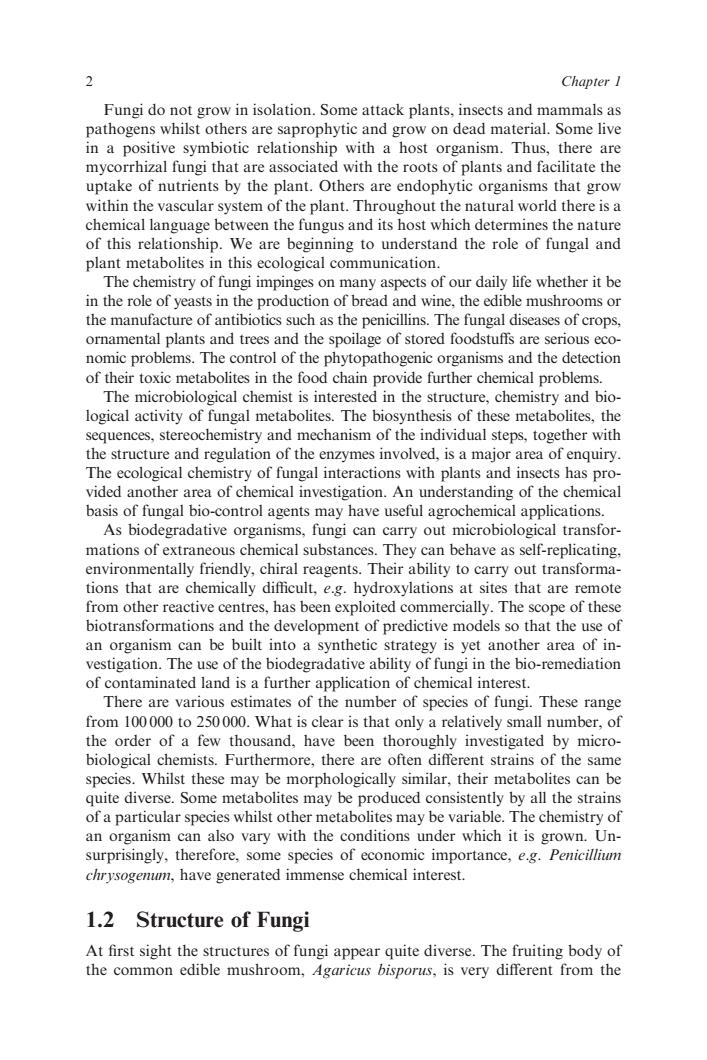正在加载图片...

2 Fungi do not grow in isolation.Some attack plants,insects and mammals as pathogens whilst others are saprophytic and grow on dead material.Some live in a positive symbiotic relationship with a host organism.Thus,there are mycorrhizal fungi that are associated with the roots of plants and facilitate the uptake of nutrients by the plant.Others are endophytic organisms that grow within the vascular system of the plant.Throughout the natural world there is a e veen the nd its host which determ s the 0 this relatic We are be plant metabolites in this ecological communication. The chemistry of fungi impinges on many aspects of our daily life whether it be in the role of yeasts in the production of bread and wine,the edible mushrooms or the manufacture of antibiotics such as the penicillins.The fungal diseases of crops. ornamental plants and trees and the spoilage of stored foodstuffs are serious eco nomic problems.The control of the phytopathogenic organisms and the detection of their toxic netabolites in the food chain provide further r che mical problem cal chem intere The bio in the ynthesis tes, sequences,stereochemistry and mechanism of the individual steps,together with the structure and regulation of the enzymes involved,is a major area of enquiry. The ecological chemistry of fungal interactions with plants and insects has pro- vided another area of chemical investigation.An understanding of the chemical basis of fungal bio-control agents may have useful agrochemical applications. As biodegradative organisms,fungi can carry out microbiological transfor mations of mical subs ance They behave as self-replicatin tally friend reagents tions that are chemically difficult,e.g.hydroxylations at site that are remote from other reactive centres,has been exploited commercially.The scope of these biotransformations and the development of predictive models so that the use of an organism can be built into a synthetic strategy is yet another area of in- vestigation.The use of the biodegradative ability of fungi in the bio-remediation of contaminated land is a further application of chemical interest. There are various estimates of the number of species of fungi.These rang from 100000 to 250000.What is clear s that only a r orde. umber,o usand,have been thoroughly investigated micro species.Whilst these may be morphologically similar,their metabolites can be quite diverse.Some metabolites may be produced consistently by all the strains of a particular species whilst other metabolites may be variable.The chemistry of an organism can also vary with the conditions under which it is grown.Un- surprisingly,therefore,some species of economic importance,e.g.Penicillium chrysogemm,have generated immense chemical interest 1.2 Structure of Fungi At first sight the structures of fungi appear quite diverse.The fruiting body of the common edible mushroom,Agaricus bisporus,is very different from theFungi do not grow in isolation. Some attack plants, insects and mammals as pathogens whilst others are saprophytic and grow on dead material. Some live in a positive symbiotic relationship with a host organism. Thus, there are mycorrhizal fungi that are associated with the roots of plants and facilitate the uptake of nutrients by the plant. Others are endophytic organisms that grow within the vascular system of the plant. Throughout the natural world there is a chemical language between the fungus and its host which determines the nature of this relationship. We are beginning to understand the role of fungal and plant metabolites in this ecological communication. The chemistry of fungi impinges on many aspects of our daily life whether it be in the role of yeasts in the production of bread and wine, the edible mushrooms or the manufacture of antibiotics such as the penicillins. The fungal diseases of crops, ornamental plants and trees and the spoilage of stored foodstuffs are serious economic problems. The control of the phytopathogenic organisms and the detection of their toxic metabolites in the food chain provide further chemical problems. The microbiological chemist is interested in the structure, chemistry and biological activity of fungal metabolites. The biosynthesis of these metabolites, the sequences, stereochemistry and mechanism of the individual steps, together with the structure and regulation of the enzymes involved, is a major area of enquiry. The ecological chemistry of fungal interactions with plants and insects has provided another area of chemical investigation. An understanding of the chemical basis of fungal bio-control agents may have useful agrochemical applications. As biodegradative organisms, fungi can carry out microbiological transformations of extraneous chemical substances. They can behave as self-replicating, environmentally friendly, chiral reagents. Their ability to carry out transformations that are chemically difficult, e.g. hydroxylations at sites that are remote from other reactive centres, has been exploited commercially. The scope of these biotransformations and the development of predictive models so that the use of an organism can be built into a synthetic strategy is yet another area of investigation. The use of the biodegradative ability of fungi in the bio-remediation of contaminated land is a further application of chemical interest. There are various estimates of the number of species of fungi. These range from 100 000 to 250 000. What is clear is that only a relatively small number, of the order of a few thousand, have been thoroughly investigated by microbiological chemists. Furthermore, there are often different strains of the same species. Whilst these may be morphologically similar, their metabolites can be quite diverse. Some metabolites may be produced consistently by all the strains of a particular species whilst other metabolites may be variable. The chemistry of an organism can also vary with the conditions under which it is grown. Unsurprisingly, therefore, some species of economic importance, e.g. Penicillium chrysogenum, have generated immense chemical interest. 1.2 Structure of Fungi At first sight the structures of fungi appear quite diverse. The fruiting body of the common edible mushroom, Agaricus bisporus, is very different from the 2 Chapter 1